Mac notebook and other portable computing is covered in The 'Book Review. iPad, iPod, iPhone, and
Apple TV news is covered in iOS News
Review. Older Macs are covered in Vintage Mac News. All prices are in US
dollars unless otherwise noted.
Purchases made through links to Amazon.com and
Apple's iTunes/iBook/App/Mac App Store support Low End Mac.
News & Opinion
Tech Trends
Software
News & Opinion
Steve Jobs' Admiration of Simplicity Launched a
Design Revolution
In a major essay for Smithsonian magazine, Steve Jobs
biographer Walter Isaacson notes that passionate to the point of
obsessive about design, Jobs insisted that his computers look perfect
inside and out. Isaacson notes that Jobs' interest in design began with
his love for his childhood home in a subdivision between San Francisco
and San Jose that had been developed by builders who, inspired by
architects Frank Lloyd Wright and developers such as Joseph Eichler and
his imitators, churned out inexpensive modernist tract houses in the
1950s for the postwar suburban migration that featured floor-to-ceiling
glass walls, open floor plans, exposed post-and-beam construction,
concrete slab floors, and lots of sliding glass doors.
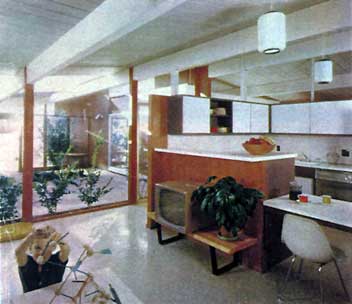
Eichler home like the one Jobs grew up in.
Jobs had related to Isaacson his appreciation for Eichler's vision
in creating houses were smart and cheap and good, bringing clean design
and simple taste to lower-income people, which instilled his passion
for making sharply designed products for the mass market.
Isaacson notes that in an era not known for great industrial
designers, Jobs working in partnerships with Hartmut Esslinger in the
1980s and Jony Ive starting in 1997 created an engineering and design
aesthetic that set Apple apart from other technology companies and
ultimately helped make it the most valuable company in the world, with
the collaborators' guiding tenet being simplicity - not only the
surface simplicity that comes from an uncluttered look and feel of a
product, but more profoundly deep simplicity "that comes from knowing
the essence of every product, the complexities of its engineering and
the function of every component."
This article is a must-read for anyone interested in design.
Publisher's note: Amazingly, there's only one photo with the
article. You'd think they'd include pictures - or at least links.
dk
Link: How Steve Jobs'
Love of Simplicity Fueled a Design Revolution
Further Reading:
Steve Jobs Grew Up in a Modernist Home (lots of photos), Growing up
Eichler: Steve Jobs and His Childhood Home,
The Home Steve Jobs Grew Up In
Apple Owners More Likely to Purchase Another Apple
Device After Positive Tech Service
PR: Nearly 60% of Apple product owners said they are somewhat
or much more likely to make another Apple purchase following their tech
support experience, according to market research firm The NPD Group's
Tech Services Study. The positive tech service also helped change
consumer perception of Apple. 31% said they had a much more positive
view of Apple after their service.
That service left almost all of the 40% of Apple owners who took
their Apple devices to the Genius Bar very happy. Nearly 90% of
consumers who used Apple's tech service said they were extremely or
very satisfied. In contrast, top 2 box satisfaction among all consumer
service interactions was 78%. A major part of their satisfaction came
from the fact that only a small percentage actually paid for their
service. According to the report, 88% of Genius Bar consumers said
their service was free compared to 78% of all consumers.
The majority of the support was for troubleshooting (37%), followed
by product repair (28%), how-to support (18%), software
installation/upgrade (11%), and product installation/setup (7%).
"Tech support is a great service for the consumer, but more
importantly its a brand-building element for the retailer and
manufacturer," says Stephen Baker, vice president of industry analysis
at NPD. "People tend to associate any type of tech support as a
negative experience, but Apple has demonstrated that those negatives
can be turned into positive brand experiences and result in a trip back
to the store."
Physical presence is key to creating those positive brand
experiences. According to the study, consumers were more genuinely
satisfied when their service was a personal interaction inside a retail
store. 53% of consumers were extremely satisfied with their in-store
experience, more so than any other type of service interaction. Younger
consumers, despite their reputation as preferring more virtual
interactions, were more likely than any other age group to want to use
the service in the store, with 45% of respondents preferring this
method.
"Retailers are rediscovering the value that services can offer the
consumer," observes Baker. "Store foot traffic has declined over the
years leaving fewer and fewer in-person interactions. Having a strong
tech support in-store model helps fill the transaction void and builds
brand awareness and satisfaction."
Methodology
A US representative sample of approximately 2,000 adults (18+)
completed on online survey through NPD's online panel in May 2012. Some
of the participants were pre-identified as consumers who had returned
or needed tech support on consumer electronic devices in the past 12
months.
Link: Nearly
60 Percent of Apple Owners More Likely to Purchase Another Apple Device
After Positive Tech Service, According to NPD
Java 1.7 Exploit Unlikely to Impact Mac Users
TUAW's Michael Rose reports that he asked for some data from
CrashPlan, which, because the online/peer backup service requires Java,
its userbase represents a good proxy for the Java installed versions on
the Mac.
Rose says CrashPlan's cofounder Matthew Dornquist quickly responded
with a random sample of 200,000 recent users, and his numbers show that
the overwhelming majority of CrashPlan's Mac users are still using Java
1.6 (92%) with a small minority on the older 1.5 version, so the
percentage running the 1.7 version targeted by the malware is
approximately zero.
"It's not often that we find ourselves thankful for out-of-date
software, but there it is," Rose observes.
Link: Java 1.7 Zero-day
Exploit Unlikely to Impact Mac Users
Tech Trends
Windows 8 'the Worst Computing Experience I've Ever
Had'
PC Games' Tim Edwards says that as a cruel trick on himself, about a
month ago he installed Windows 8 on his main PC to see what it was
like.
He doesn't like it and doesn't hold back in explaining why in
painstaking, caustic detail, observing:
"I don't think it's an exaggeration to say that
Windows 8 is the worst computing experience I've ever had."
"I don't think it's an exaggeration to say that Windows 8 is the
worst computing experience I've ever had. As a desktop operating
system, it's annoying, frustrating, irritating, and baffling to use.
I've tried on many occasions to explain exactly why it's so awful to
use day-to-day, and most of the time, smoke starts pouring out of my
ears. I thought it would be better to get down exactly what the issues
are and why you should avoid it."
Then he really lets fly.
He takes particular umbrage at how Microsoft have managed to break
one of the basic functions of a personal computer GUI - switching
between running programs, noting that Windows programs in the
interface mode formerly known as Metro have no window controls and
take up the entire screen. Therefore, there's no easy way to switch
between them using onscreen controls. You have to engage in unfamiliar
mouse movements to swap between them, and adding insult to injury, core
apps that offer basic OS functionality are Metro-only. And in Edwards'
estimation "they're awful" like all other Metro apps, such as the email
app which he says is horrendous - the worst email client he's ever
used, while there are two versions of Internet Explorer, both bad.
There's more. Much more.
Link: Why
I'm Uninstalling Windows 8
IDC Lowers PC Outlook as Shipments Decline Ahead of
Fall Product Updates
PR: The worldwide PC market is now expected to grow just a
minuscule 0.9% in 2012, as midyear shipments slow. According to the
International Data Corporation (IDC) Worldwide Quarterly PC Tracker,
367 million PCs will ship into the market this year, up just a fraction
of a percent from 2011 and marking the second consecutive year of
growth below 2%.
Slowing growth in Asia/Pacific has reduced the impact of emerging
market growth, while more mature regions like the United States have
seen volume decline. Consumers have been hit by weak economic
conditions, but are also waiting to see what Windows 8 and Ultrabook
products will look like while considering spending instead on other
products like media tablets and smartphones. Product updates later this
year should revive PC growth, IDC predicts, but it will be a more
pronounced competitive environment with likely some confusion among
buyers about new product features as well as where they will get the
most value for their money.
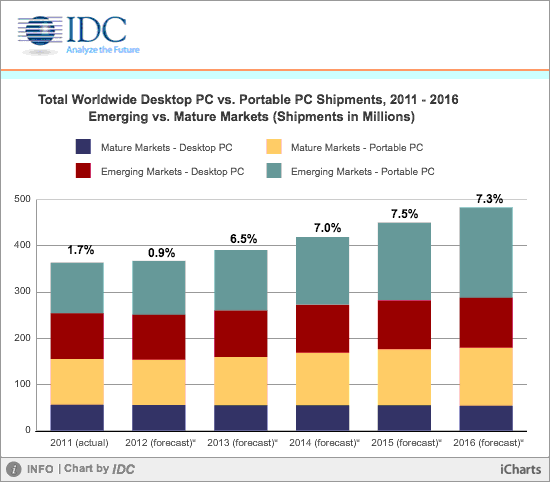
IDC anticipates that uncertainty about product updates should be
largely addressed by the end of this year and may be accompanied by a
modest improvement on the economic front. Still, consumers and
businesses alike are expected to remain cautious with spending and when
deciding to replace older products. This will put a damper on medium-
and long-term growth prospects, both of which were lowered slightly in
the medium- and long-range forecast. IDC now expects worldwide PC
shipment growth will average 7.1% from 2013-2016, down from the 8.4%
compound annual growth rate (CAGR) previously forecast for
2012-2016.
"The US market will remain depressed until Windows 8 products hit
the shelves in the fourth quarter of 2012," says David Daoud, research
director, Personal Computing at IDC. "The industry is responding by
reducing shipments of PCs and clearing Windows 7-based inventories to
pave the way for a new generation of systems. But, as we move into the
tail end of the third quarter, PC activity will continue to slow as
demand drops. The third-quarter back to school season is also proving
to be a challenging period, despite prices dropping to their lowest
levels. We expect the year will end with shipments in the US falling by
3.7%, marking the second consecutive year of contraction."
"IDC remains optimistic that PC penetration opportunities in
emerging markets will form the bulwark of the market and help sustain
double-digit Portable PC growth in the long run. However, a host of
all-too-familiar variables will lead to a subdued second half of the
year with only consumer notebooks remaining in growth mode for all of
2012," says Jay Chou, senior research analyst with IDC's Worldwide
Quarterly PC Tracker. "Factors such as Windows 8 coupled with
Ultrabooks could present a positive turn of events next year, but it
also faces some initial hurdles; chief of which is that buyers must
acclimate themselves to an operating system that is a dramatic
departure from existing PC paradigms. The PC ecosystem faces some work
to properly educate the market."
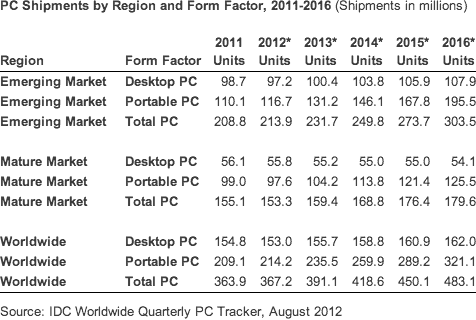
Mature Markets include US, Western Europe, Japan, and Canada.
Emerging Markets include Asia/Pacific (excluding Japan), Latin America,
Central and Eastern Africa, Middle East and Africa.
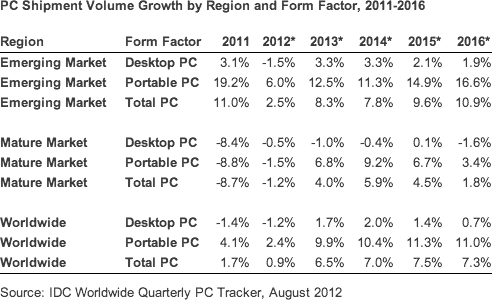
Desktop and portable PC shipments for both mature and emerging
markets during the 2011-2016 forecast.
Taxonomy Note: PCs include desktop, mini notebook, and other
portable PCs, and do not include handhelds or media tablets such as the
Apple iPad or Android tablets
IDC's Worldwide Quarterly PC Tracker gathers PC market data in 80
countries by vendor, form factor, brand, processor brand and speed,
sales channel and user segment.
Many Prospective Digital Camera Buyers Plan to
Spend More than Twice the Average Point-and-Shoot Price
PR: Digital camera owners who plan to buy a new camera within
the next year are willing to spend more than they were two years ago,
according to market research firm The NPD Group's Next Camera Study
Part II. Over a quarter of current digital camera owners stated they
were at least somewhat likely to purchase a camera during the coming
year. Among them, 46% said they would spend $300+, up nearly 10
percentage points from 2010 and more than twice the current
point-and-shoot average selling price of $149.
 "Even
though the percent of current digital camera owners who said they were
going to purchase a new device hasn't changed much since 2010, the fact
that those who want to buy are willing to spend more than they were two
years ago will certainly help boost a market that has been declining,"
says Liz Cutting, executive director and senior imaging analyst at NPD.
"That willingness to invest more in their next digital camera should
greatly help the mirrorless segment where consumers are looking for
high quality in a small package."
"Even
though the percent of current digital camera owners who said they were
going to purchase a new device hasn't changed much since 2010, the fact
that those who want to buy are willing to spend more than they were two
years ago will certainly help boost a market that has been declining,"
says Liz Cutting, executive director and senior imaging analyst at NPD.
"That willingness to invest more in their next digital camera should
greatly help the mirrorless segment where consumers are looking for
high quality in a small package."
Among those intending to spend at least $200 on their next camera,
awareness of mirrorless interchangeable lens cameras shot up to 40%,
double that of 2010. According to the survey, consumers who said they
were considering purchasing a mirrorless camera were most attracted to
the high image quality of the camera, followed by interchangeable lens
capacity and compact size. Some of the biggest barriers for consumers
were willingness to spend at least $500, and perceived potential lack
of DSLR quality.
"Mirrorless cameras are much higher on consumers radar screens and
are being held both to a high quality standard while at the same time
are being sized up for value," says Cutting. "Marketers of mirrorless
cameras must prove that big things come in small sizes, and are worth
the investment."
A US representative sample of 3,200 adults from NPD's online panel
took part in the survey from June 20 to July 5.
Link: Nearly
Half of Digital Camera Owners Looking to Buy a New Camera Plan to Spend
More Than Twice the Average Point-and-Shoot ASP, According to
NPD
Software
Free Shade Utility Hides Your Messy Desktop with
the Click of a Button
PR: Shade is a new, free OS X utility that hides your messy
Desktop under the photo or graphic of your choice with the click of a
button. Just drag an image to the Shade icon. Click the Shade leaf icon
to turn Shade on and off. Shade is Retina Display compatible.
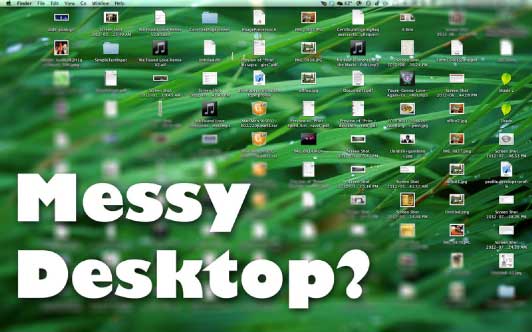
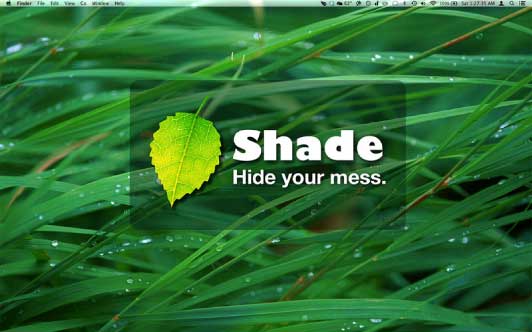
System requirements:
- OS X 10.6 or later
- 64-bit processor
Shade is freeware
Available on the Mac App Store.
Link:
Shade
AnyClient Web Launches Free Online FTP Client
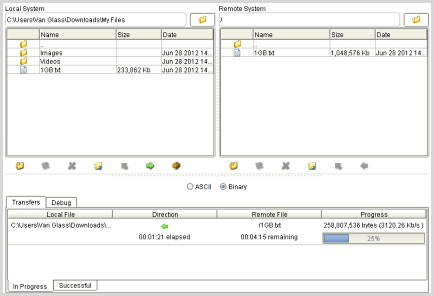 PR: JSCAPE has
announced the release of AnyClient Web, an intuitive Web based file
transfer client available for Windows, Mac OS X and Linux operating
systems. AnyClient Web supports all major file transfer protocols
including FTP/S, SFTP, WebDAV, AFTP and Amazon S3.
PR: JSCAPE has
announced the release of AnyClient Web, an intuitive Web based file
transfer client available for Windows, Mac OS X and Linux operating
systems. AnyClient Web supports all major file transfer protocols
including FTP/S, SFTP, WebDAV, AFTP and Amazon S3.
"Users need to be able to transfer files without having to locate,
purchase, install and learn complicated file transfer software.
AnyClient solves this problem by offering a simple web based file
transfer client that is accessible from anywhere in the world. Best of
all it's completely free," says JSCAPE CEO Van Glass.
AnyClient Web is a perfect solution for users looking for a
no-hassle method of transferring files, and claimed to be especially
popular with users connecting from shared computing environments where
the installation of file transfer software is prohibited such as in
Internet cafes and university computer labs.
Link: AnyClient
Desktop Mac
Deals
Low End Mac updates the following price trackers monthly:
For deals on current and discontinued 'Books, see our 13" MacBook and MacBook Pro,
MacBook Air, 13" MacBook Pro, 15" MacBook Pro, 17" MacBook Pro, 12" PowerBook G4, 15" PowerBook G4, 17" PowerBook G4, titanium PowerBook G4,
iBook G4, PowerBook G3, and iBook G3 deals.
We also track iPad,
iPhone, iPod touch, iPod classic, iPod nano, and iPod shuffle deals.





 "Even
though the percent of current digital camera owners who said they were
going to purchase a new device hasn't changed much since 2010, the fact
that those who want to buy are willing to spend more than they were two
years ago will certainly help boost a market that has been declining,"
says Liz Cutting, executive director and senior imaging analyst at NPD.
"That willingness to invest more in their next digital camera should
greatly help the mirrorless segment where consumers are looking for
high quality in a small package."
"Even
though the percent of current digital camera owners who said they were
going to purchase a new device hasn't changed much since 2010, the fact
that those who want to buy are willing to spend more than they were two
years ago will certainly help boost a market that has been declining,"
says Liz Cutting, executive director and senior imaging analyst at NPD.
"That willingness to invest more in their next digital camera should
greatly help the mirrorless segment where consumers are looking for
high quality in a small package."

 PR: JSCAPE has
announced the release of AnyClient Web, an intuitive Web based file
transfer client available for Windows, Mac OS X and Linux operating
systems. AnyClient Web supports all major file transfer protocols
including FTP/S, SFTP, WebDAV, AFTP and Amazon S3.
PR: JSCAPE has
announced the release of AnyClient Web, an intuitive Web based file
transfer client available for Windows, Mac OS X and Linux operating
systems. AnyClient Web supports all major file transfer protocols
including FTP/S, SFTP, WebDAV, AFTP and Amazon S3.
